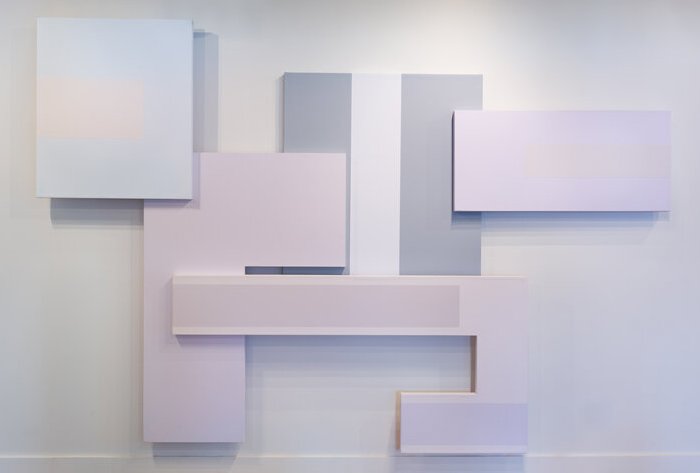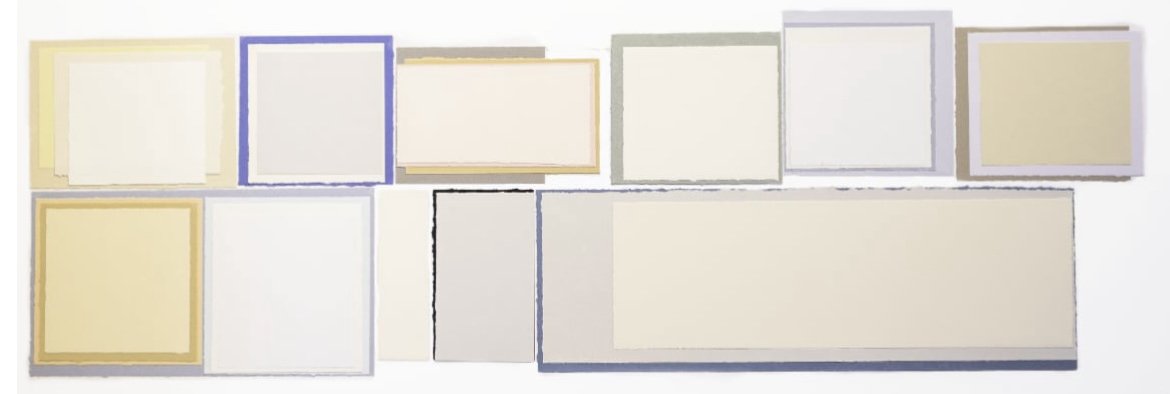five by square
paper on dibond
48 x 48 x 6 inches
2020
side by side
paper on matboard
20 x 50 inches
2020
adjacencies
latex on masonite
72 x 72 x 4 inches
2021
pentaptych
latex on canvas
24 x 109 x 3.5 inches
2022
triptych
latex on canvas
50 x 880 x 3 inches
2022
Strokes in Blue
Latex on Masonite
96 x 96 x 5 inches
2022
Shredded State of the Disunited Union
Paper and Mixed Media on wire panels
64 x 106 x 3 inches
2022
Stephen Nobel
evolution of abstraction
“Minimalism is not an elimination of things.
It can be the amalgamation of a lot of things, brought to a very refined state...”
— brice marden, artist
Stephen Nobel’s minimalist constructs are the embodiment of an artistic journey that has evolved over decades. While Nobel’s abstract pieces may appear to lean toward simplification and refinement, they are in no way simple. Employing the language of color, pattern, shape, scale, shadow, texture, and three-dimensionality, Nobel’s work is a masterful exploration of the relationships between formal visual elements.
Originally, Nobel made paintings with patterns. Over time, a single brush stroke came to be seen as a singular shape, which led to deconstructing a painting into its foundational components of scale, pattern and color. Replacing brush strokes, colored paper was used like paint—layered, folded, torn, soaked and shaped. He adopted the grid as an armature for choreographing shapes in color.
Nobel’s art continues to evolve, going beyond the grid to making three-dimensional pieces that are integral to the wall on which they are installed. In these works, the contribution of shadows and the spaces in-between parts play a vital role in the overall work.
As Bozeman gallery Echo Arts observed, “Nobel is on an exploratory path, an investigation of this love affair with color. It is exciting to see the square fall-way to three-dimensional constructions.”
artist’s statement
I came west from New York City to Livingston to learn from this place; to evolve as an artist and “rise or fall by braving perils and finding discoveries specific to [myself].”* This is my story of discovery and artistic evolution.
It starts with my intention that another person see in my art that which I see, thereby forming a personal attachment. First, I have to create. Facing a blank canvas, one is presented with the eternal question: now what, where to start? I go to the studio to see what I have not seen, yet.
Every painting, construction or installation is an evolution that starts with the first touch. My affair with abstraction has evolved to afford me a visual vocabulary unbound by narrative or allegory. I try to be fluent with the fundamental components of art: scale, pattern, color, shape, three-dimension, shadow and texture.
In terms of scale, I want to embrace it physically. It should reveal its “all-over” presence, extending visually even beyond its physical borders. Abstract patterns act as an armature for presenting the essence of what is to be seen.
Eyes wiser than mine crafted Navajo chevron-patterned rugs and Gees Bend quilts. They inspired me as I sought to find a straightforward pattern on which to compose. On a trip to Berlin, my renewed interest in Bauhaus revealed the infinite possibilities of the grid.
Years ago, I had begun painting with patterns. But my new-found western sensibility revealed something new to me in the paintings. The art evolved as my sense of place evolved. The brushstrokes could also be discreet elements of the composition. Even a single brush stroke came to be seen as a shape, or an element in my vocabulary. It meant deconstructing my work into its essential elements. I shelved paint in favor of color-saturated paper, and I found I could shape paper in painterly ways – deckled and layered, folded, torn, soaked and molded into new elements.
The grid made traditional composition obsolete but, almost like an armature for choreographing shapes in color, astonishingly rich. It became my stage. A designer-friend said about my work, “my eyes dance on the surface.” For me, that was a sublime reward.
As Echo Arts of Bozeman observed during my solo exhibition in early 2021, “one would be quick to note that Nobel’s two-dimensional constructions allude most directly to Josef Albers’ “Homage to the Square” and specifically, the principles therein that reference the relativity of color. As the viewer engages more specifically with the breadth of this show, a trans-formation occurs. Color theory begets form. The square loses its reference point as the subtle interaction of color creates new space.”
The art evolved. If I had not produced a large series of these compositions, I would not have seen what could be done by going beyond the grid, while taking color, shape, and shadow even further – in 3D and on the wall.
As Echo Arts discovered: “Nobel is on an exploratory path, an investigation of this love affair with color. It is exciting to see the square fall-way to three-dimensional constructions: some linear, some a cacophony of shapes; some germinating from within the space, and some directing the space it exists within. There is no parsing of the media here, rather a dramatic unpacking of it.”
By evolving “off the grid”, the wall became integral to the art – “of the wall”, rather than simply “on the wall.” This heralded a departure in scale; the installation became the subject of the art, while retaining its minimal composition.
I embrace artist Brice Marden’s sense of the word “Minimalism...not an elimination of things. It can be the amalgamation of a lot of things, brought to a very refined state…” Marden went further: “In the late 1960s and early 1970s (NB: when I [Steve] was a student at the School of the Museum of Fine Arts, Boston), many artists began to produce works that demonstrate remarkable formal restraint. Although few artists have embraced the term “minimalism,” the designation became widely used to refer to artists who employed reductive, geometric forms in their work, in sharp contrast to the high expressive approaches that pervaded American abstract expressionism. Artists featured monochromatic palettes, repetition, and light to achieve their respective compositions. The grid and four-sided forms figure largely as antitheses to subjective expression.”
In this exhibition, my installation is composed with elements cleated independently to the wall on a non-compositional grid, creating an “all over” effect in space, shadow and color that appears to extend beyond its boundaries. I see relationships between the parts, mindful that elements that could have been viewed as brush strokes in the past are now resonant facts.
The color palette is hued to subtle adjacencies along a scale of soft light. As the work evolved, I was intrigued by the shadows and harmonic colors – the meditative spaces in between. They reveal the dynamics of singular parts coming together naturally. What I have read, witnessed and thought about recently reveals just how adjacent we all are to one another, despite discord and disruption.
Art in mixed media evolves. And so, abstraction evolves with me discovering what’s next. The twenty elements of Strokes in Blue are installed adjacent to one another while leaving space for reflection. They also yield insight to ways we are connected to one another and the spaces we occupy – especially those spaces designed by those rare architects who are also artists. That’s where my art belongs. The architect and I are allies. Yet at the same time, while adjacencies spell hope, disunity surrounds us. The Shredded State of the Disunited Union, in four panels, forces the painterly application of new material “in mâché” to another dimension beyond color, shape, shadow – to texture.
But I am not finished yet. Although, speaking of finish, artists are often asked “when do you know?” I reply, “We have to let it go where it wants to go. It is finished when it no longer is asking for more.”
I have a little note in my studio that reminds me, “If I hadn’t done that, I would not be doing this.” I will return to what I have made before, learn from it and even risk doing what needs to be done to see in different ways that which I have not yet seen before. That’s my evolution.











